SENSŌ-JI Temple, located in Tokyo's Asakusa district, is a 1,000-year-old sanctuary offering spirituality and culture. The temple features a magnificent Kannon statue, five-story pagoda, and Zen gardens, as well as the Thunder Gate, which welcomes visitors with two colossal statues of Wind and Thunder gods. A purification ritual at the Chozuya fountain and Omikuji divination stalls are also available.
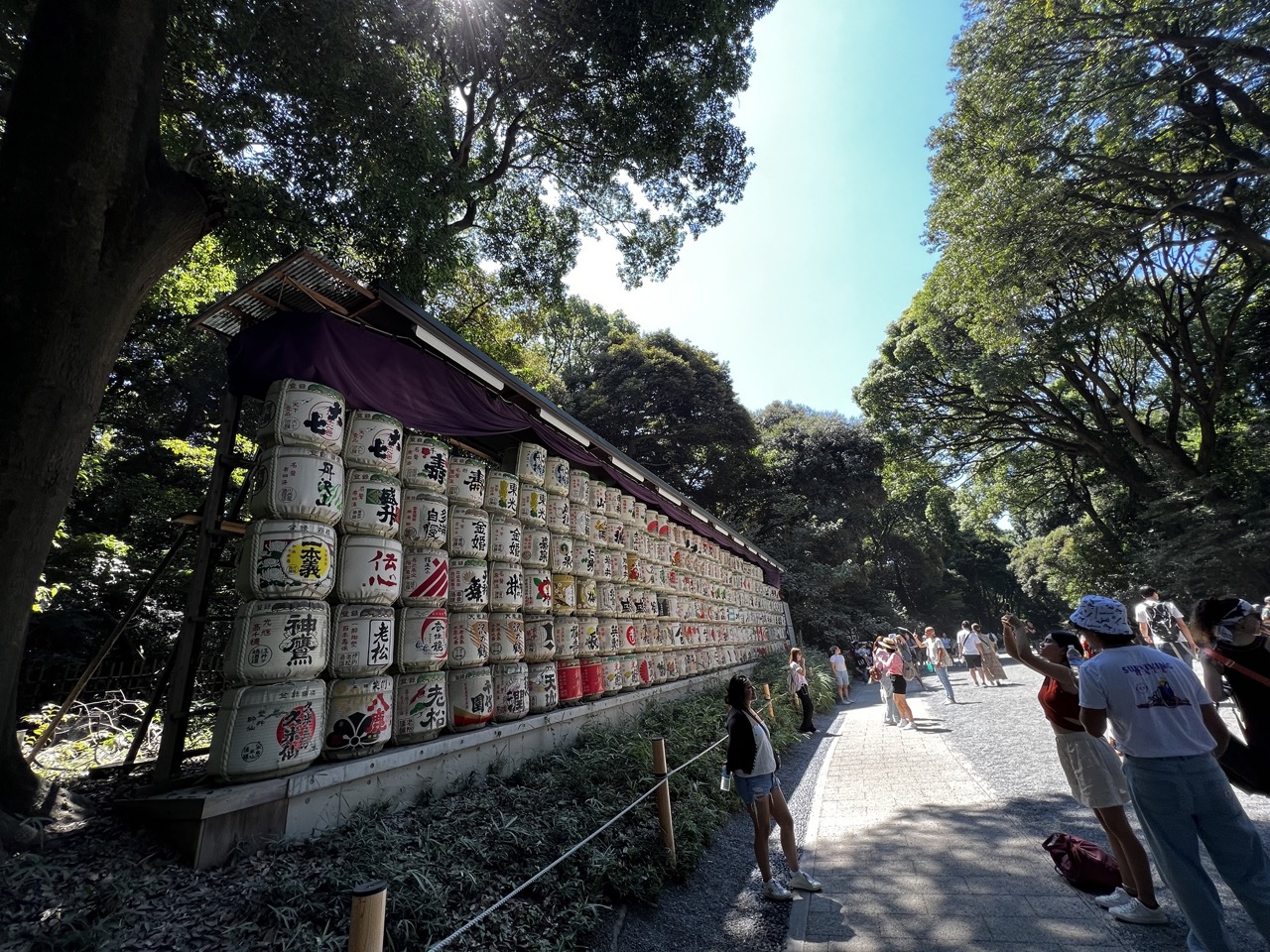

1. Overall Rating (0–10) — 7.5
This photograph captures the serene yet vibrant energy of a traditional Japanese shrine, where cultural ritual meets natural beauty. The towering display of sake barrels, inscribed with wishes, creates a striking visual rhythm, while the dappled sunlight filtering through the trees enhances the scene’s spiritual atmosphere. Though the composition is slightly cluttered by tourists, the image successfully conveys a sense of place and devotion, balancing cultural authenticity with a sense of lived experience.
2. Composition (0–10) — 7.0
The diagonal line of the barrel wall leads the eye through the frame, creating depth and guiding the viewer toward the background. The placement of the tree on the left provides natural framing, though the scattered figures on the right verge on distracting, slightly disrupting the visual harmony.
3. Lighting (0–10) — 8.0
Bright, natural sunlight creates vivid contrast between the sunlit barrels and the shaded foliage, enhancing texture and detail. The interplay of light and shadow adds dimension, while the clear blue sky contributes to the image’s uplifting mood.
4. Color & Tone (0–10) — 7.5
The palette is rich with earthy tones from the barrels and deep greens of the trees, punctuated by the bright white and red of the calligraphy. The vibrant blue sky provides a striking backdrop, giving the image a balanced and harmonious tonal range.
5. Creativity (0–10) — 7.0
The photograph captures a unique cultural practice with authenticity and reverence. While the subject is inherently meaningful, the composition relies on the visual strength of the barrels rather than innovative perspective or narrative framing.
6. Technical Quality (0–10) — 8.0
The image is sharp and well-focused, with clear detail in the barrels and foliage. The exposure is balanced, capturing both highlights and shadows effectively, though some minor overexposure in the sky slightly reduces dynamic range.
7. Emotional Impact (0–10) — 7.5
The scene evokes a sense of peace and tradition, inviting the viewer to reflect on the quiet rituals of human hope and faith. The presence of visitors adds a layer of relatability, making the spiritual feel both timeless and present.
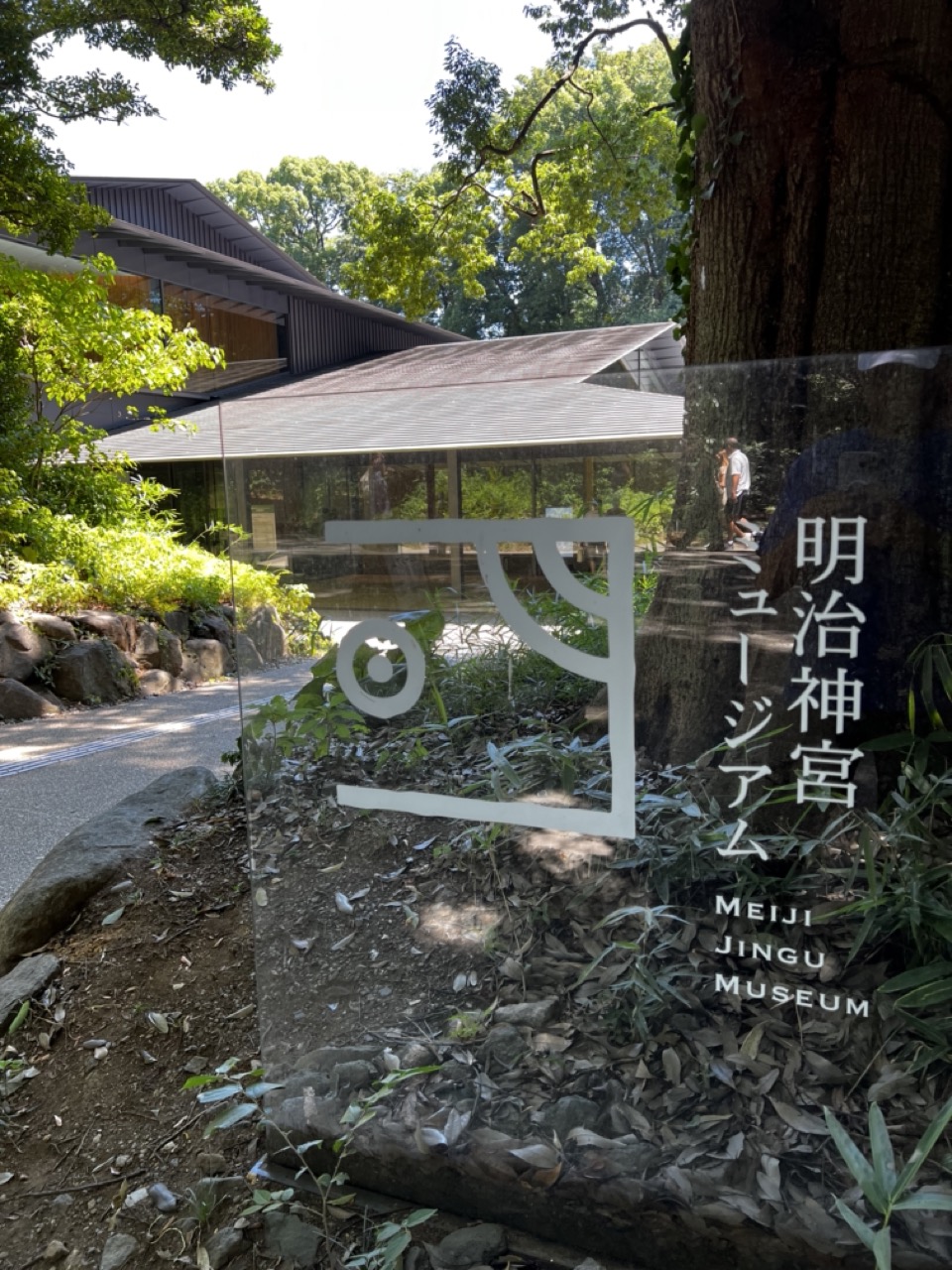

1. Overall Rating (0–10) — 7.0
This photograph captures the serene integration of modern architecture with natural surroundings, evoking a sense of quiet reverence befitting a cultural site. The layered composition—foreground signage, mid-ground building, and lush background—creates depth and context, though the reflective surface of the sign slightly disrupts clarity. The image succeeds in conveying place and atmosphere, balancing documentation with aesthetic sensitivity.
2. Composition (0–10) — 7.5
The framing uses the glass sign as a natural leading element, drawing the eye toward the museum structure while incorporating the surrounding foliage and tree trunk to create a balanced, layered scene. The diagonal path and roofline guide the viewer’s gaze, enhancing spatial interest.
3. Lighting (0–10) — 7.0
Natural daylight provides even illumination, with dappled sunlight filtering through the trees, adding texture and depth. The bright sky is slightly overexposed, but the shadows under the eaves and on the ground add dimension and contrast.
4. Color & Tone (0–10) — 7.5
The palette is dominated by natural greens and earthy browns, with the white of the sign and text offering a clean, modern contrast. The tones are rich and harmonious, reinforcing the tranquil, organic atmosphere of the setting.
5. Creativity (0–10) — 6.5
The use of the reflective sign introduces a subtle layer of visual complexity, merging the physical environment with the site’s identity. While the concept is straightforward, the interplay of transparency, reflection, and architecture adds a thoughtful, layered quality.
6. Technical Quality (0–10) — 8.0
Sharp focus is maintained across the image, particularly in the mid-ground and foreground. The details of the foliage, building materials, and text are clear, and the exposure is well-managed despite the bright outdoor conditions.
7. Emotional Impact (0–10) — 7.0
The image evokes a calm, contemplative mood, inviting the viewer to pause and reflect on the harmony between culture and nature. The quiet presence of the museum and its surroundings suggests a space of reverence and connection.
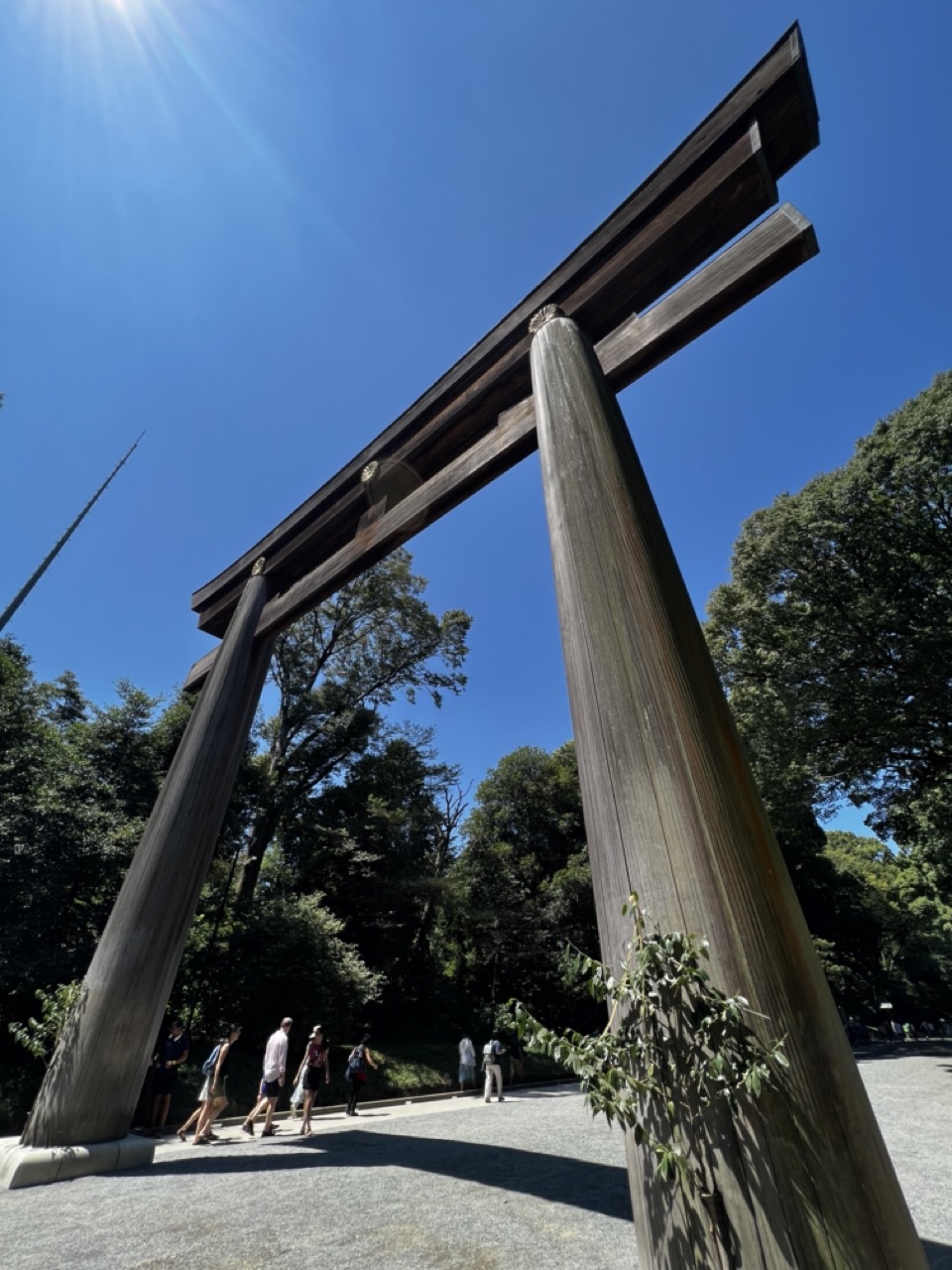

1. Overall Rating (0–10) — 7.5
This photograph captures the grandeur of a traditional Japanese torii gate under a brilliant blue sky, evoking a sense of reverence and cultural depth. The low-angle perspective amplifies the gate’s imposing presence, while the interplay of sunlight, shadow, and natural elements adds a dynamic quality. While the composition is strong, the inclusion of modern visitors slightly disrupts the timeless atmosphere, creating a subtle tension between tradition and contemporary life.
2. Composition (0–10) — 8.0
The low-angle shot emphasizes the torii’s scale and verticality, creating a powerful leading line toward the arch. The framing balances the massive structure with the surrounding trees and sky, though the scattered people introduce minor visual distraction.
3. Lighting (0–10) — 9.0
The bright, direct sunlight enhances the scene’s clarity and depth, casting sharp shadows that define texture and form. The sun flare in the upper left adds a touch of natural drama, reinforcing the image’s vividness.
4. Color & Tone (0–10) — 8.0
The deep blue sky contrasts beautifully with the weathered brown wood and lush green foliage, creating a rich, harmonious palette. The high saturation enhances the image’s vibrancy without appearing unnatural.
5. Creativity (0–10) — 7.5
The perspective and framing elevate a familiar subject into something monumental. The inclusion of people grounds the scene in reality, offering a narrative of human interaction with sacred space, though it slightly dilutes the spiritual isolation often associated with such sites.
6. Technical Quality (0–10) — 8.5
The image is sharp, well-focused, and free of noise, with excellent detail visible in the wood grain and foliage. The exposure is well-balanced, capturing both highlights and shadows effectively.
7. Emotional Impact (0–10) — 8.0
The photograph conveys a quiet awe and reverence, inviting the viewer to contemplate the intersection of nature, tradition, and human presence. The strong visual structure and atmospheric lighting evoke a sense of peace and wonder.
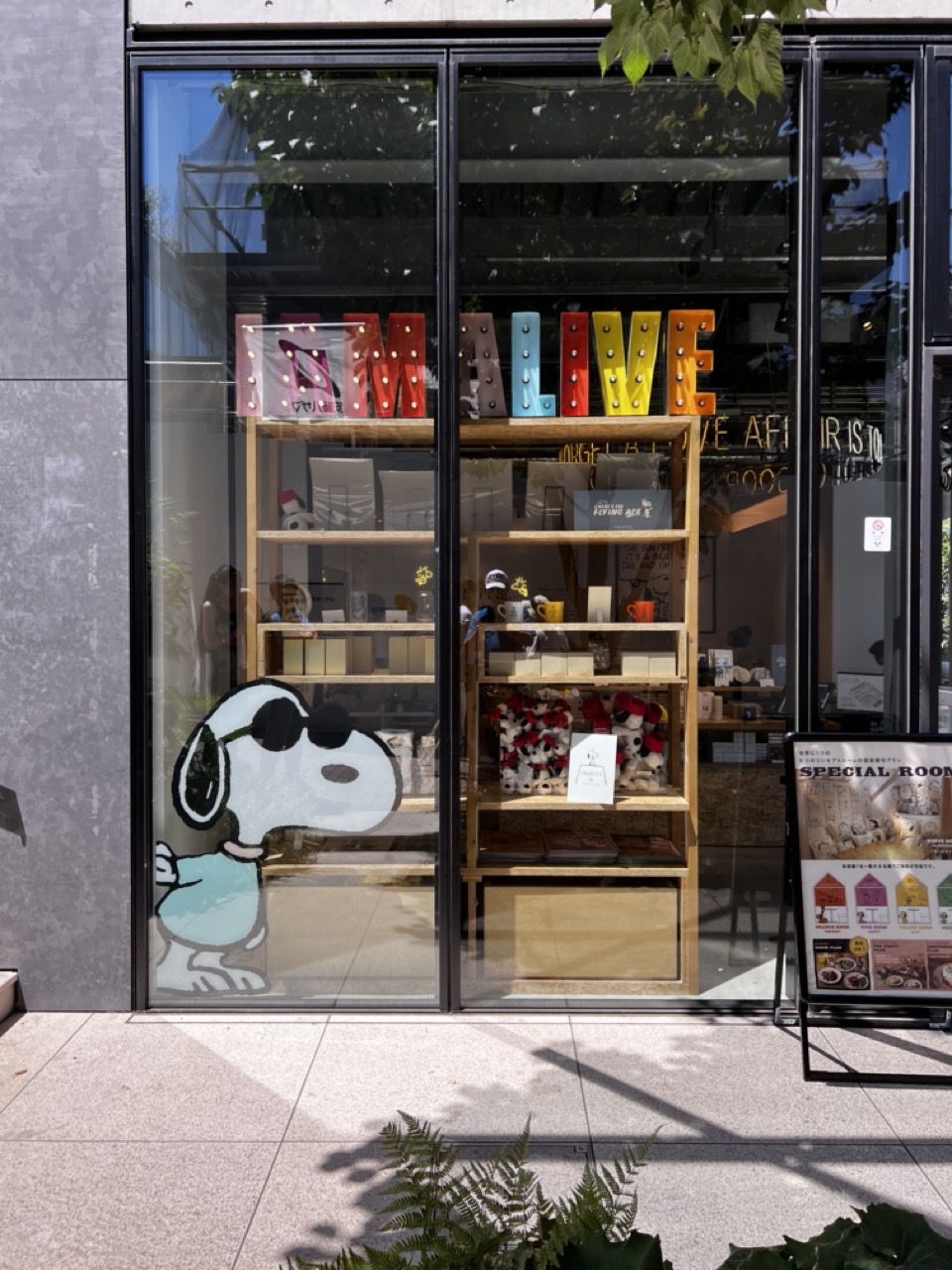

1. Overall Rating (0–10) — 6.8
This photograph captures a vibrant storefront with a playful, inviting energy, where the juxtaposition of whimsical design and urban architecture creates a compelling visual narrative. The colorful marquee letters and Snoopy cutout add charm and personality, while the reflections in the glass introduce layers of depth and context. However, the cluttered interior and overexposed highlights slightly detract from the image’s overall cohesion, keeping it from achieving a more polished aesthetic.
2. Composition (0–10) — 7.0
The central framing of the glass window draws focus to the display, with the Snoopy decal and shelves creating a balanced composition. The foreground fern and sidewalk add depth, though the right-side signage slightly disrupts visual flow.
3. Lighting (0–10) — 7.5
Bright, natural daylight enhances the scene’s clarity and color, casting soft reflections on the glass that add dimension. The strong sunlight creates a high-contrast effect, with some areas overexposed but overall maintaining a lively, daytime mood.
4. Color & Tone (0–10) — 7.5
The vivid, varied hues of the marquee letters contrast beautifully with the muted gray facade and neutral tones of the interior. The warm wooden shelves and the cool green of the fern introduce complementary tones, contributing to a dynamic yet harmonious palette.
5. Creativity (0–10) — 7.0
The image successfully blends commercial appeal with artistic flair, using familiar pop culture elements to create a sense of fun. The integration of reflections and layered elements adds a modern, urban storytelling quality.
6. Technical Quality (0–10) — 7.5
The image is sharp and well-focused, with clean details visible in both the foreground and interior. The exposure is generally strong, though some highlights in the glass are slightly blown out.
7. Emotional Impact (0–10) — 7.0
The cheerful, nostalgic elements evoke a sense of joy and curiosity, inviting viewers to imagine the space within. The playful tone and urban setting create a relatable, upbeat atmosphere that resonates with a broad audience.
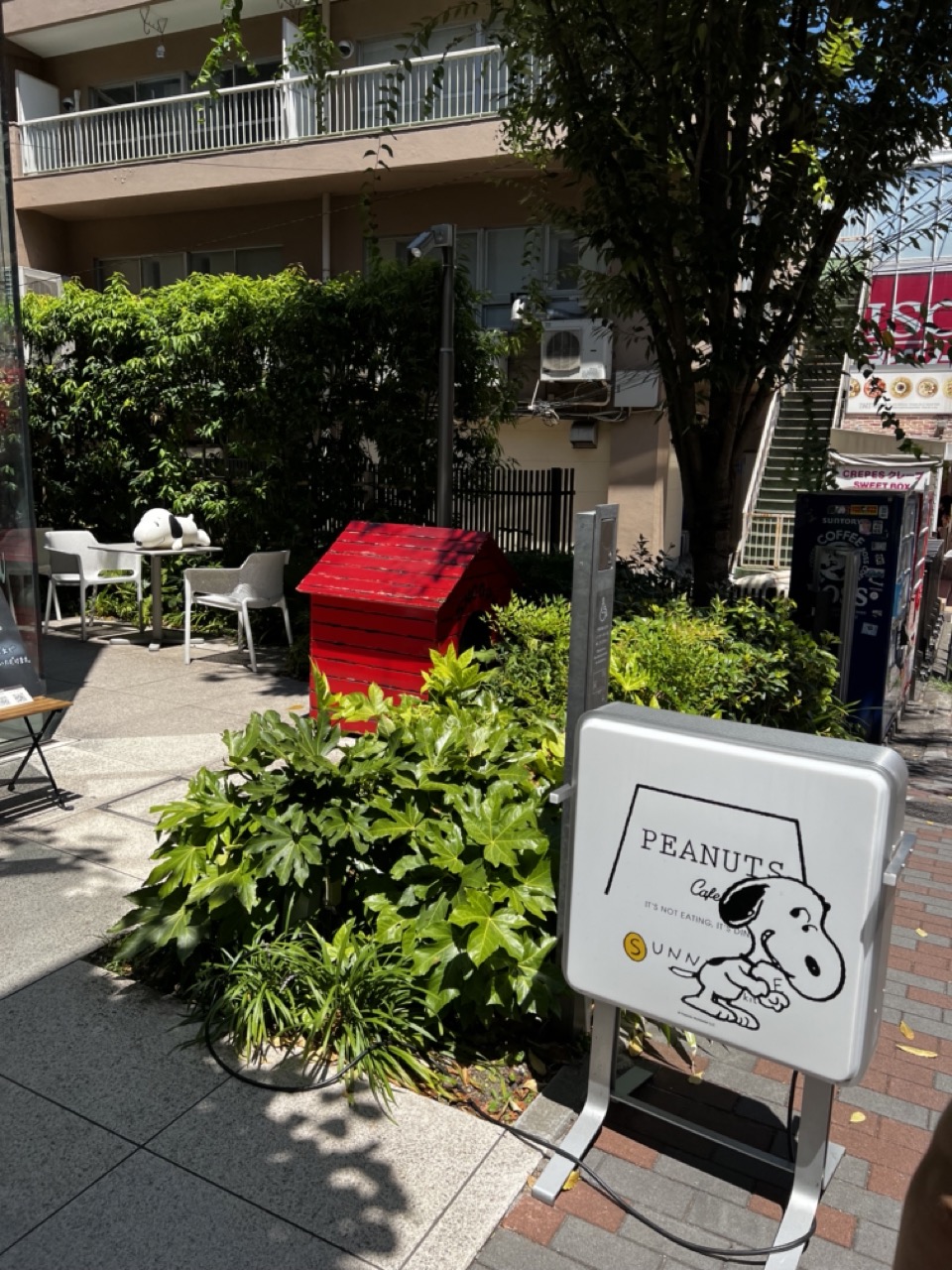

1. Overall Rating (0–10) — 7.0
This photograph captures a whimsical and inviting corner of a Snoopy-themed café, where playful design meets urban greenery. The vibrant red doghouse and cheerful signage create a sense of nostalgia and charm, while the natural foliage softens the hard lines of the surrounding architecture. Though the scene is slightly cluttered with signage and pavement elements, the overall mood is light and welcoming, with a strong sense of place that feels both curated and authentic.
2. Composition (0–10) — 6.5
The frame is well-balanced with the red doghouse and sign drawing the eye, though the cluttered foreground and background slightly distract from the central subject. The diagonal path and tree create leading lines that guide the viewer into the scene.
3. Lighting (0–10) — 7.5
Bright, natural sunlight enhances the vividness of the red doghouse and the lush greenery, casting soft shadows that add depth. The lighting feels candid and warm, contributing to the scene’s cheerful, daytime ambiance.
4. Color & Tone (0–10) — 7.0
The palette is dominated by the bold red of the doghouse and the deep greens of the foliage, creating a strong visual contrast. The neutral tones of the pavement and building help the colorful elements stand out without overwhelming the composition.
5. Creativity (0–10) — 7.5
The choice to highlight a themed café space with a playful, pop-culture motif is clever and engaging. The integration of the Snoopy branding into a real-world urban setting feels both imaginative and grounded in a recognizable cultural touchstone.
6. Technical Quality (0–10) — 7.0
The image is sharp and well-focused, with clear details in the signage and foliage. The exposure is balanced, capturing both highlights and shadows effectively without harsh overexposure.
7. Emotional Impact (0–10) — 7.0
The photograph evokes a sense of joy and nostalgia, particularly for fans of the Peanuts characters. It invites the viewer into a small, cheerful escape within the city—a place where whimsy and everyday life intersect.
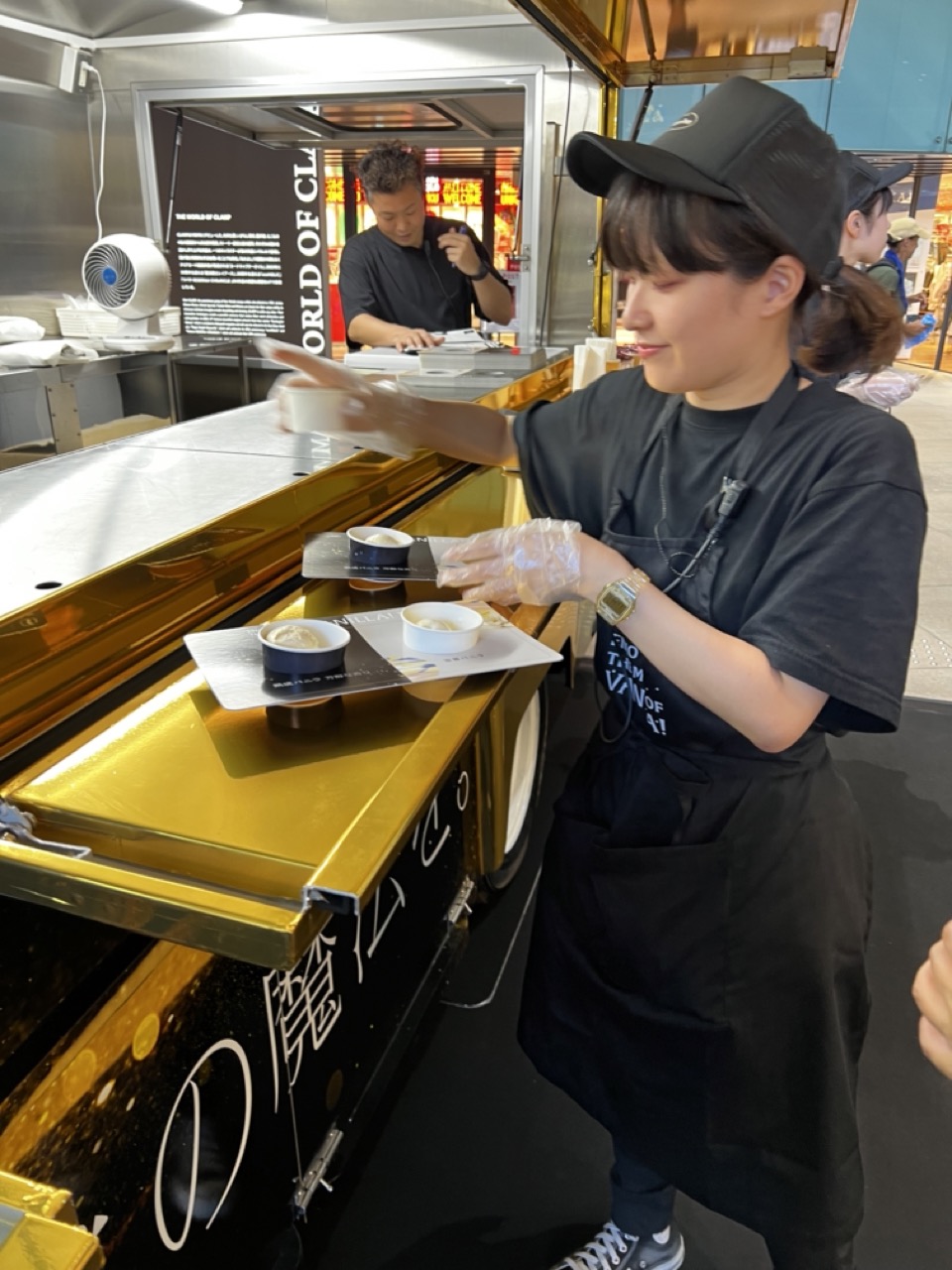

1. Overall Rating (0–10) — 7.0
This photograph captures a moment of focused service at a sleek, high-end food stall, where the golden counter and branded presentation elevate a simple act of food preparation into something ceremonial. The subject’s gentle smile and precise movements convey warmth and professionalism, while the background activity adds a layer of authenticity. The image succeeds in blending commercial branding with human connection, though the slightly cluttered framing and muted lighting prevent it from feeling fully polished.
2. Composition (0–10) — 6.5
The subject is well-placed in the foreground, drawing attention to her actions, but the overlapping elements—such as the tray, hand, and background figure—create visual tension. A tighter crop would enhance focus on the central narrative.
3. Lighting (0–10) — 6.0
The lighting is functional and even, likely from overhead fluorescent sources, which flattens the scene and reduces the richness of the gold surfaces. While it clearly illuminates the subject, it lacks the warmth and dimension to elevate the mood.
4. Color & Tone (0–10) — 7.0
The dominant black and gold palette creates a sense of luxury and cohesion, with the white cups and signage providing clean contrast. The overall tone is subdued but intentional, reinforcing the upscale, branded nature of the experience.
5. Creativity (0–10) — 6.5
The image captures a real-world moment with a stylized presentation, blending commercial and personal elements. While not highly original in concept, it effectively communicates the atmosphere of a curated food experience.
6. Technical Quality (0–10) — 7.5
The image is sharp and well-focused, with clean detail visible in the subject’s hands, gloves, and the food containers. The depth of field is adequate, keeping the main action clear while softly blurring the background.
7. Emotional Impact (0–10) — 6.5
There’s a quiet sense of dedication and care in the subject’s expression and posture, inviting the viewer into a moment of service. The emotional resonance is subtle but present, particularly in the contrast between the polished environment and the human warmth at its center.
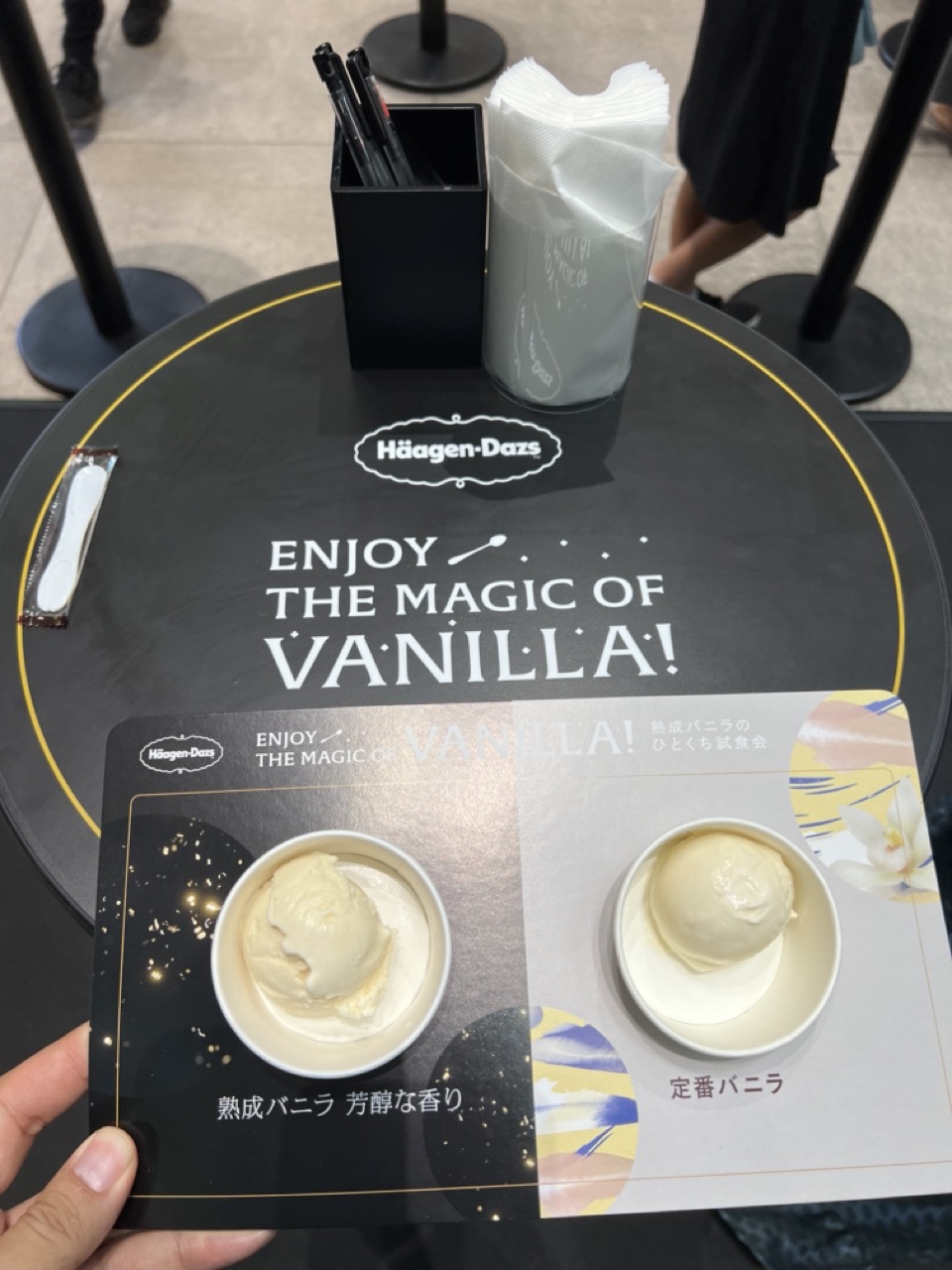

1. Overall Rating (0–10) — 6.0
This photograph captures a moment of indulgence at a Häagen-Dazs vanilla tasting, where branding and product take center stage. The composition is functional and straightforward, emphasizing the experience of sampling premium ice cream. While the image effectively conveys the theme of vanilla luxury, it lacks visual dynamism—its flat perspective and cluttered background diminish the sense of occasion, making it feel more like a casual snapshot than a curated scene.
2. Composition (0–10) — 5.5
The frame centers on the tasting card and table mat, creating a layered, slightly cluttered effect. The hand holding the card adds a personal touch but disrupts the balance, while the background elements—stanchions and legs—distract from the main subject.
3. Lighting (0–10) — 6.0
The lighting is even and bright, likely from overhead indoor fixtures, which clearly illuminates the product and branding. However, the flatness of the light minimizes shadows and depth, giving the image a commercial, unmoored feel.
4. Color & Tone (0–10) — 6.5
The palette is dominated by the black tabletop and white ice cream, with subtle pops of color from the card’s design. The contrast between the dark surface and light cream enhances visual clarity, though the overall tone remains muted and lacks warmth.
5. Creativity (0–10) — 5.5
The concept is straightforward and promotional, focusing on product presentation rather than artistic expression. The inclusion of Japanese text and branded elements grounds the image in its cultural context, but it doesn’t push beyond the expected.
6. Technical Quality (0–10) — 7.0
The image is sharp and in focus, with clean details on the ice cream and text. The exposure is well-balanced, and there are no visible technical flaws.
7. Emotional Impact (0–10) — 5.0
The image evokes a sense of anticipation and mild pleasure, but the lack of atmosphere and personal connection limits its emotional resonance. It captures a moment of consumption rather than a moment of joy.
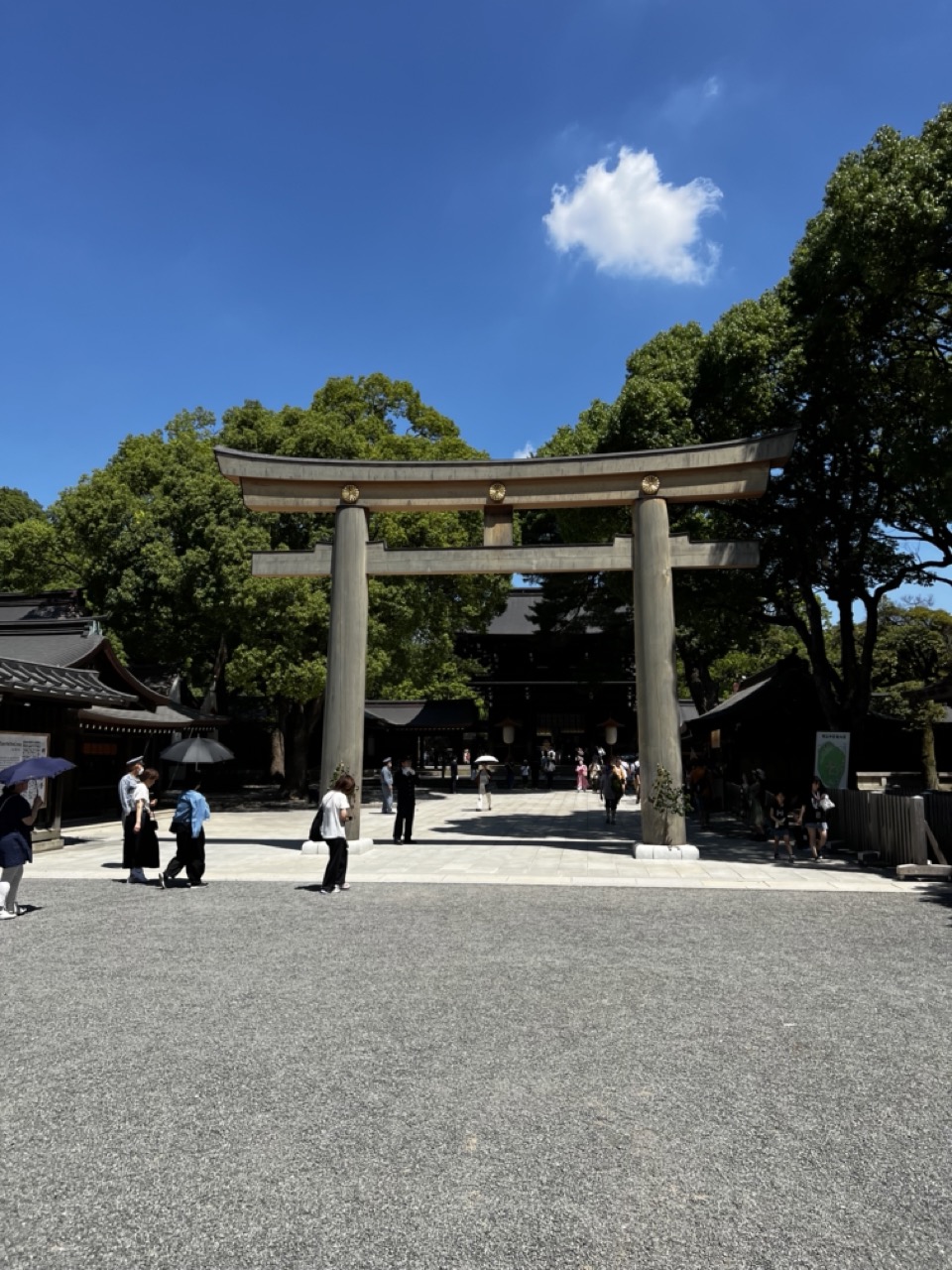

1. Overall Rating (0–10) — 7.0
This photograph captures the serene grandeur of a traditional Japanese shrine under a vast, cloud-dappled sky, where the massive torii gate stands as a solemn threshold between the earthly and the sacred. The bright daylight and expansive gravel courtyard lend a sense of openness and reverence, while the scattered visitors add a quiet human presence without disrupting the scene’s tranquility. Though compositionally sound, the image leans slightly toward documentation rather than artistic interpretation, lacking a more evocative angle or moment to elevate its emotional weight.
2. Composition (0–10) — 7.0
The torii is centered and dominates the frame, creating a strong focal point, while the wide gravel foreground and surrounding trees provide balance and depth. The low-angle perspective emphasizes the gate’s scale, though the inclusion of too many people and structures on the sides slightly disrupts the symmetry.
3. Lighting (0–10) — 8.5
Bright, natural sunlight enhances the crispness of the scene, casting soft shadows that define form and texture. The clear blue sky and single white cloud create a striking contrast, adding visual interest and a sense of calm.
4. Color & Tone (0–10) — 8.0
The palette is harmonious, with deep greens of the trees, the rich brown of the torii, and the vibrant blue of the sky creating a naturally balanced and pleasing contrast. The neutral gray gravel grounds the image, allowing the colors to pop without overwhelming.
5. Creativity (0–10) — 6.5
The image is a strong representation of cultural space, but it remains conventional in its approach—capturing a familiar scene with clarity rather than reimagining it. A more unique vantage point or moment of interaction could have added narrative depth.
6. Technical Quality (0–10) — 8.5
The image is sharp, well-focused, and properly exposed, with clean details in both the foreground and background. The dynamic range handles the bright sky and shaded areas effectively.
7. Emotional Impact (0–10) — 7.0
There’s a quiet dignity and peace in the scene that resonates with viewers, evoking a sense of reverence and cultural connection. While not emotionally charged, the image invites contemplation and a moment of stillness.
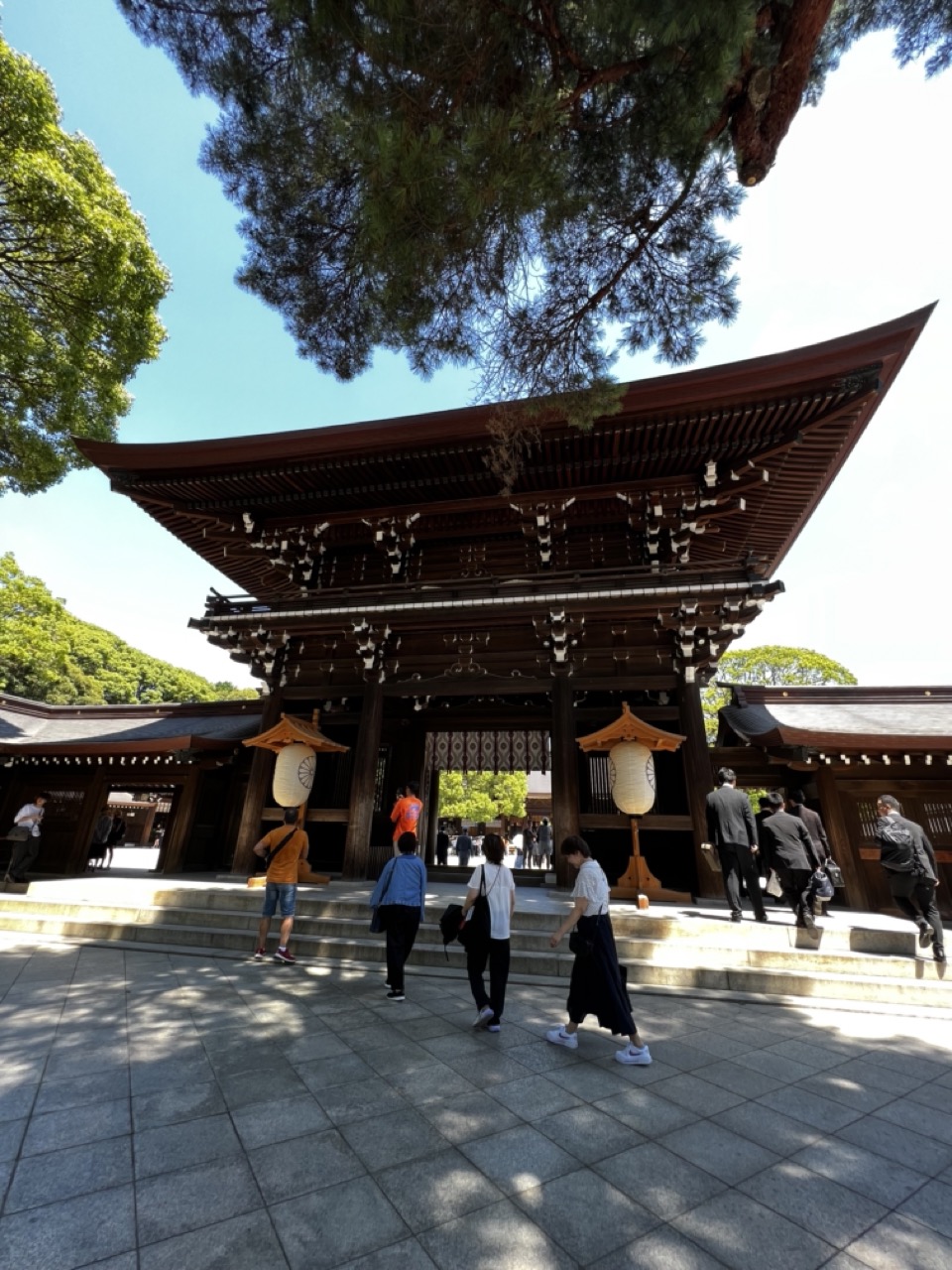

1. Overall Rating (0–10) — 7.5
This photograph captures the serene grandeur of a traditional Japanese shrine under a clear blue sky, where the interplay of light, shadow, and architecture evokes a sense of reverence and timelessness. The low-angle perspective emphasizes the imposing scale of the structure, while the movement of visitors adds life and context without disrupting the tranquil mood. The image succeeds in balancing cultural authenticity with visual elegance, though the composition’s slight busyness tempers its overall harmony.
2. Composition (0–10) — 7.0
The low-angle framing enhances the shrine’s majesty, but the inclusion of too many figures and foreground elements creates a slightly cluttered feel. The diagonal lines of the steps and shadows guide the eye toward the entrance, though the heavy tree canopy at the top slightly disrupts visual flow.
3. Lighting (0–10) — 8.0
Bright, natural sunlight enhances the rich wood tones and creates dynamic shadows that add depth and texture. The contrast between sunlit areas and dappled shade beneath the trees contributes to a vivid, three-dimensional quality.
4. Color & Tone (0–10) — 7.5
The warm brown of the wooden structure contrasts beautifully with the deep green of the trees and the pale blue sky. The tones are balanced and natural, with a slight coolness in the shadows that prevents the image from feeling overly warm or flat.
5. Creativity (0–10) — 7.0
The choice of perspective and timing captures both architectural splendor and human presence, grounding the image in lived experience. While not highly experimental, the approach effectively conveys the site’s cultural significance with a sense of quiet storytelling.
6. Technical Quality (0–10) — 8.0
Sharp focus and clear detail across the frame—especially in the intricate woodwork and lanterns—demonstrate strong technical execution. The exposure is well-managed, with no blown-out highlights or lost shadows.
7. Emotional Impact (0–10) — 7.5
The image conveys a peaceful reverence, inviting the viewer to pause and reflect. The presence of people suggests continuity and connection to tradition, fostering a sense of quiet contemplation and spiritual calm.
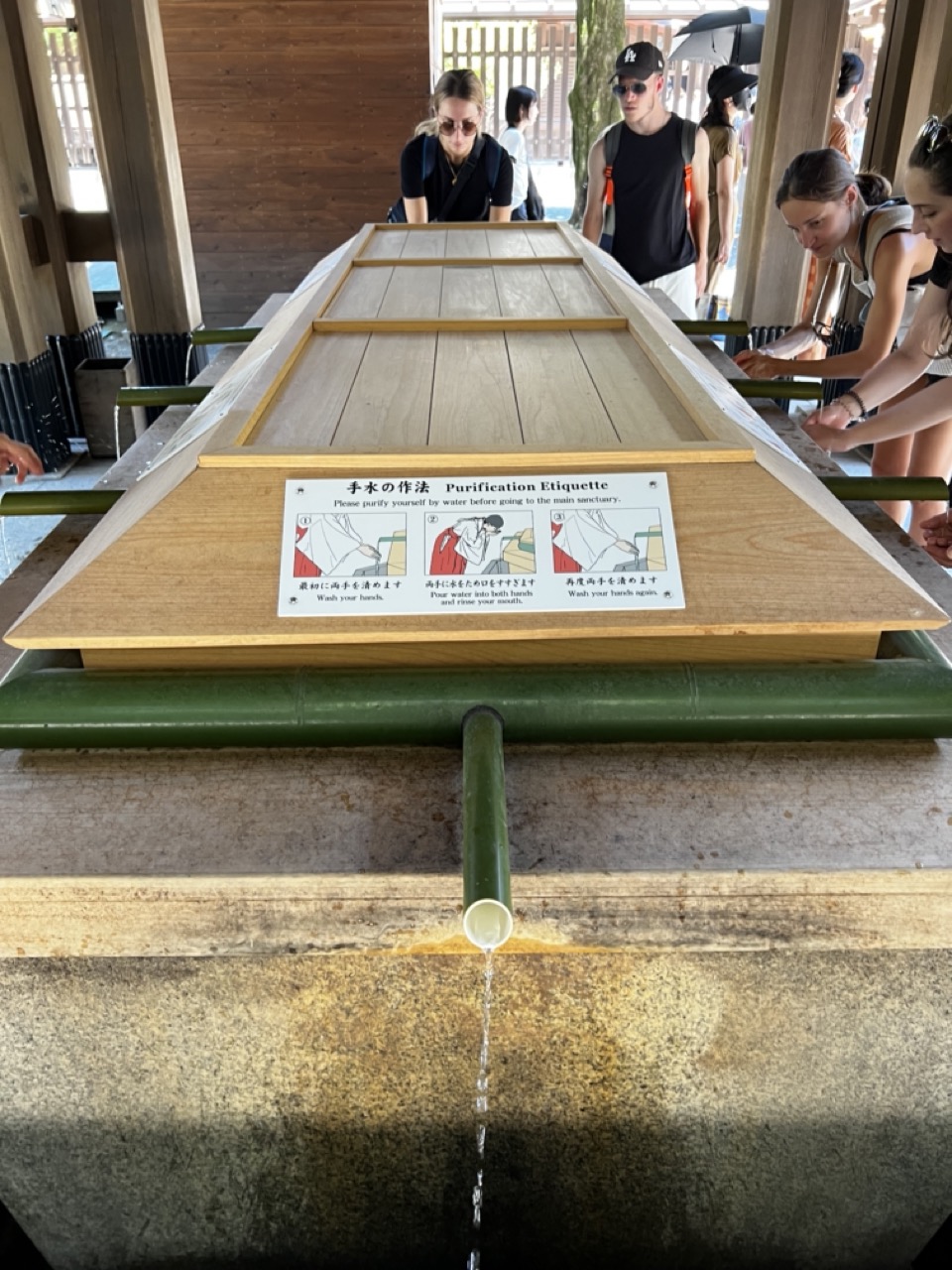

1. Overall Rating (0–10) — 7.0
This photograph captures a quiet, ritualistic moment at a Japanese shrine, where the tradition of purification is both observed and lived. The composition draws the viewer into the scene through the central water spout and the clear instructional signage, grounding the image in cultural specificity. While the presence of tourists introduces a sense of modernity, the image retains a contemplative mood, balanced between tradition and everyday life. The slightly cluttered background, however, tempers the visual harmony.
2. Composition (0–10) — 7.0
The central placement of the purification basin and the diagonal flow of water create a strong visual axis, guiding the eye from the spout to the participants. The framing is slightly tight, but the inclusion of people on both sides adds narrative depth and context.
3. Lighting (0–10) — 6.5
Natural daylight illuminates the scene evenly, highlighting the textures of wood, stone, and bamboo. The shadows are soft and directional, suggesting a bright but diffused overhead light, which enhances the sense of place without creating harsh contrasts.
4. Color & Tone (0–10) — 6.5
The palette is grounded in earthy tones—warm wood, muted stone, and deep green bamboo—creating a cohesive and naturalistic feel. The white of the sign and water provide subtle contrast, though the overall tone is subdued, reflecting the calm, reverent atmosphere.
5. Creativity (0–10) — 7.0
The image successfully blends documentary realism with cultural storytelling, capturing a moment of shared ritual in a way that feels both authentic and visually compelling. The inclusion of the instructional sign adds a layer of narrative clarity, inviting the viewer to engage with the practice.
6. Technical Quality (0–10) — 7.5
Sharp focus and clear detail are maintained throughout, particularly on the sign and water flow. The depth of field is sufficient to keep the main subject in focus while softly blurring the background, supporting visual hierarchy.
7. Emotional Impact (0–10) — 6.5
The image evokes a sense of quiet reverence and cultural connection, inviting reflection on ritual and tradition. While the presence of tourists introduces a subtle disconnect, the shared act of purification fosters a quiet sense of community and mindfulness.
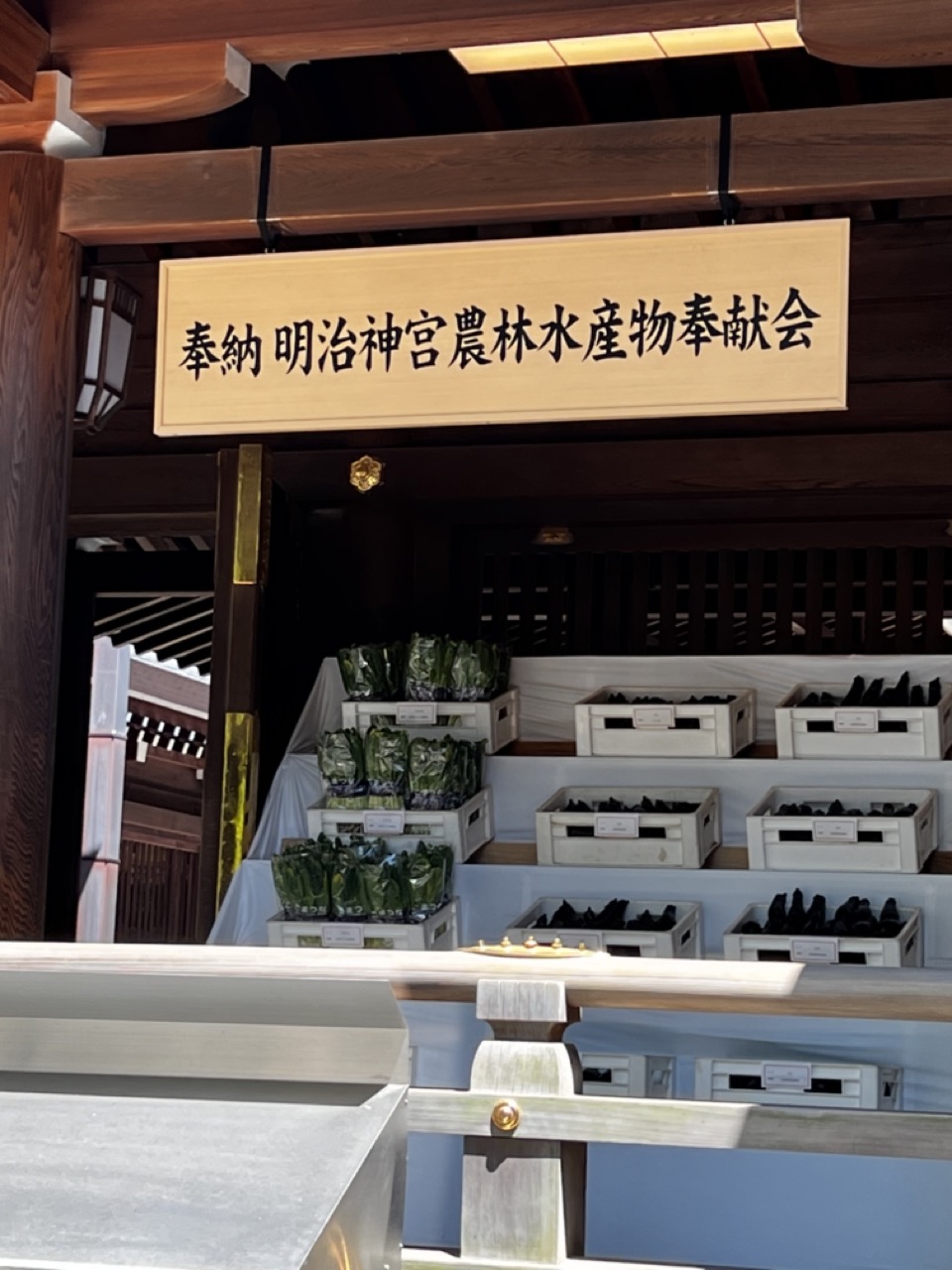

1. Overall Rating (0–10) — 6.0
This image captures a solemn and culturally rich moment at a Shinto shrine, where agricultural and aquatic offerings are presented with reverence. The wooden sign and neatly arranged crates convey a sense of tradition and ritual, yet the composition feels slightly static and lacks visual dynamism. While the scene is authentic and meaningful, it could benefit from a more engaging perspective or stronger lighting to elevate its emotional resonance.
2. Composition (0–10) — 5.5
The subject is centered and clearly framed, but the cluttered foreground and off-center sign disrupt visual harmony. A tighter crop would enhance focus on the offerings and the sign.
3. Lighting (0–10) — 5.0
Natural daylight illuminates the scene evenly, but the flat lighting diminishes depth and texture. The overhead light source creates subtle shadows but fails to add mood or drama.
4. Color & Tone (0–10) — 5.5
The palette is muted, dominated by earthy browns and whites, with a subtle contrast from the green produce. The lack of vibrant color limits the image’s visual impact, though the tonal range remains balanced.
5. Creativity (0–10) — 6.0
The photograph documents a unique cultural practice with authenticity, but the approach is observational rather than interpretive. A more artistic angle or timing could have conveyed deeper narrative or emotional nuance.
6. Technical Quality (0–10) — 7.0
The image is sharp and well-focused, with clean details visible in the sign and crate labels. The exposure is consistent, though some areas lack tonal richness.
7. Emotional Impact (0–10) — 5.5
The scene evokes quiet respect for tradition, but the viewer remains distanced by the image’s clinical clarity and lack of emotional lighting. It feels more like documentation than a moment of connection.
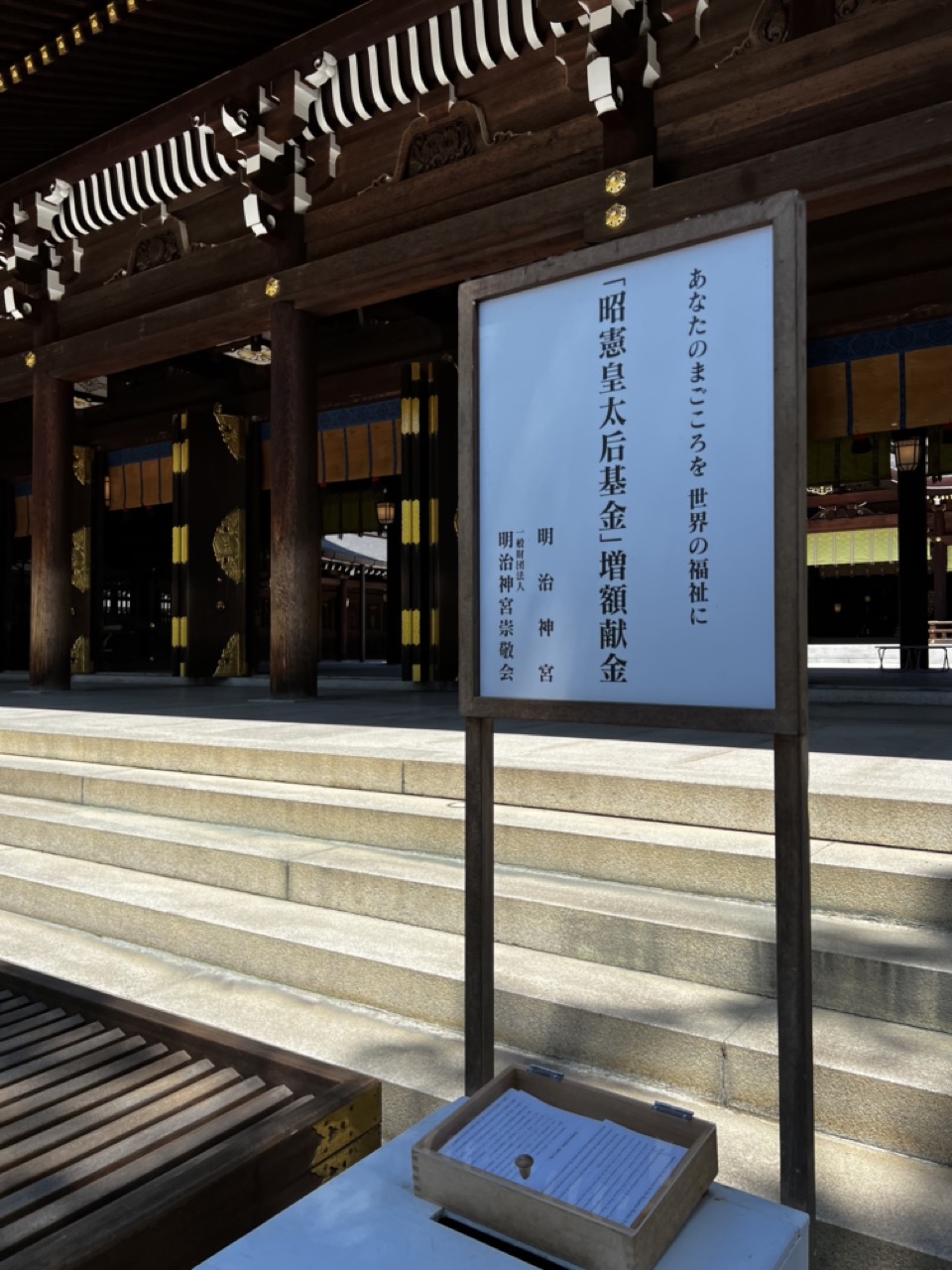

1. Overall Rating (0–10) — 7.0
This photograph captures the solemn dignity of a traditional Japanese shrine, where cultural reverence and spiritual intent are palpable in every detail. The composition balances the sacred architecture with a human element—the donation sign—offering a quiet invitation to participation. While the image is grounded in realism and clarity, it holds a restrained emotional resonance, slightly hindered by the clinical lighting and the absence of a human presence to animate the space.
2. Composition (0–10) — 7.5
The sign is placed off-center, creating visual interest, while the leading lines of the steps draw the eye toward the temple’s entrance. The wooden bench and box in the foreground add depth and context, grounding the scene in everyday ritual.
3. Lighting (0–10) — 6.5
Natural daylight illuminates the scene evenly, with soft shadows enhancing texture. However, the light is somewhat flat and unvaried, lacking the warmth or contrast that could elevate the mood.
4. Color & Tone (0–10) — 7.0
The palette is restrained and harmonious, dominated by earthy browns, muted grays, and the pale blue of the sign. The tonal balance is clean, with a subtle contrast between the dark wood and bright steps, reinforcing the sense of order and tranquility.
5. Creativity (0–10) — 6.5
The image is observational rather than interpretive, capturing a moment of quiet devotion without overt artistic manipulation. Its strength lies in its cultural authenticity and subtle narrative potential.
6. Technical Quality (0–10) — 8.0
The image is sharp and well-focused, with clean lines and clear text. The exposure is balanced, and the depth of field effectively keeps both the sign and the background in view.
7. Emotional Impact (0–10) — 6.0
The photograph conveys a sense of peace and reverence, but the absence of people or motion keeps the emotional connection at a distance. It invites contemplation rather than evokes strong feeling.
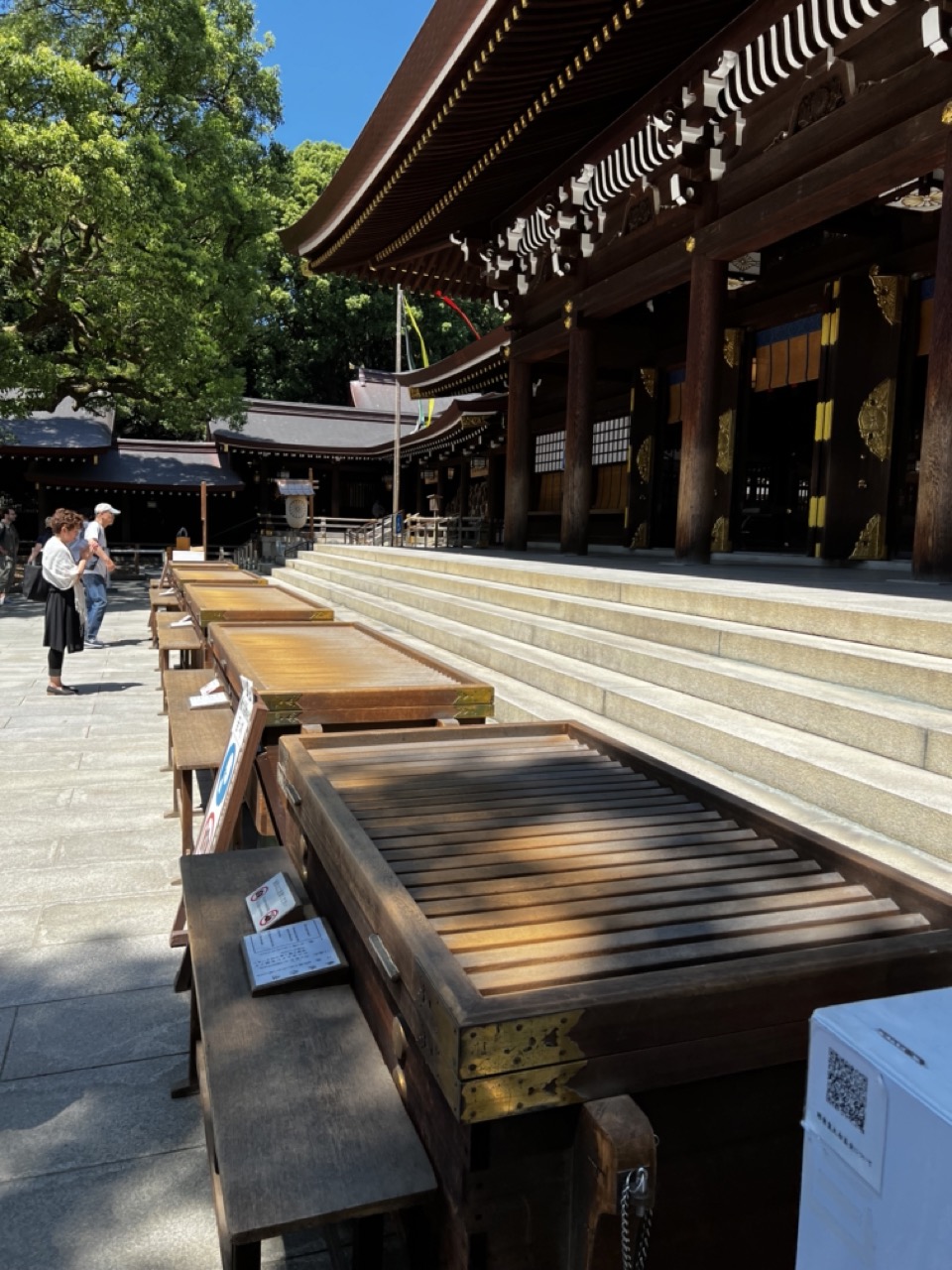

1. Overall Rating (0–10) — 7.0
This photograph captures the serene dignity of a Japanese shrine on a bright, sunlit day, where traditional architecture harmonizes with the natural world. The wooden prayer tablets and stone steps lead the eye toward the temple’s grand entrance, evoking a sense of ritual and reverence. While the scene is visually rich in cultural detail, the composition feels slightly unbalanced due to the foreground clutter and the presence of modern elements like the QR code box, which disrupt the timeless atmosphere.
2. Composition (0–10) — 6.5
The diagonal line of prayer tablets creates a strong leading line, guiding the viewer toward the temple entrance. However, the cluttered foreground and the intrusion of the white box in the bottom right disrupt visual flow and weaken the sense of balance.
3. Lighting (0–10) — 8.0
Bright, natural sunlight enhances the textures of the wood and stone, casting sharp shadows that add depth and dimension. The high contrast between light and shade emphasizes the architectural details and contributes to the crisp, vivid quality of the image.
4. Color & Tone (0–10) — 7.0
The warm browns of the wooden structures contrast beautifully with the lush green trees and the deep blue sky, creating a balanced and harmonious palette. The tones are rich and natural, though the overall brightness slightly flattens some of the mid-tone details.
5. Creativity (0–10) — 6.5
The image successfully captures a moment of everyday devotion within a sacred space, blending tradition with contemporary life. While the concept is strong, the inclusion of modern elements like the QR code box and signage tempers the overall artistic cohesion.
6. Technical Quality (0–10) — 7.5
The image is sharp and well-focused, with excellent detail in the wood grain and architectural features. The exposure is well-handled, with no blown-out highlights or lost shadows, showcasing strong technical execution.
7. Emotional Impact (0–10) — 7.5
The photograph evokes a quiet sense of peace and reverence, inviting the viewer to reflect on the continuity of tradition and the quiet rituals of daily life. The presence of visitors adds a human element, grounding the scene in authenticity and emotional resonance.
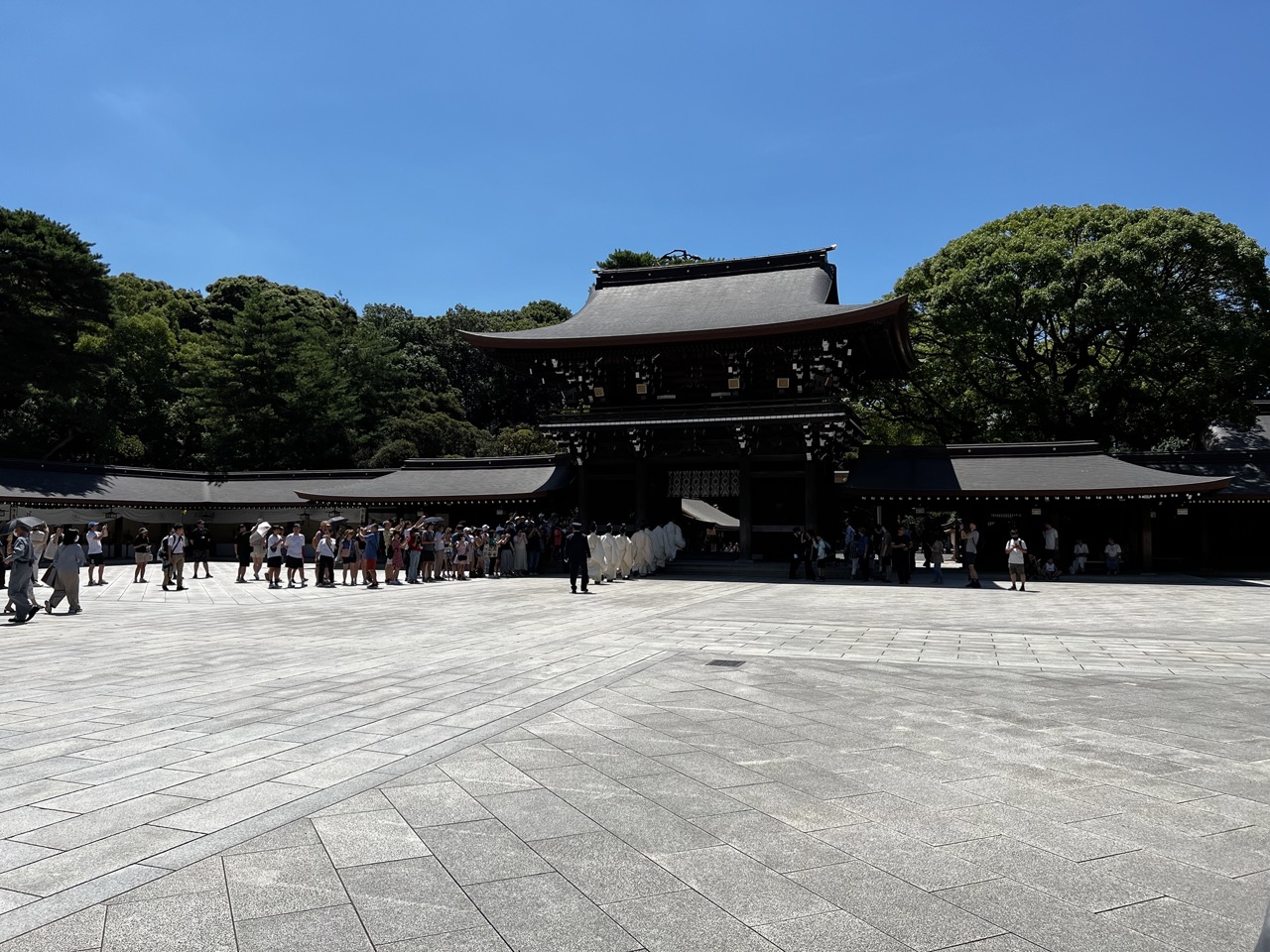

1. Overall Rating (0–10) — 7.0
This photograph captures the serene grandeur of a traditional Japanese shrine on a clear, sunlit day, where the vast stone courtyard frames a gathering of visitors in quiet reverence. The strong architectural lines and expansive sky lend a sense of timelessness, though the sheer number of people slightly dilutes the spiritual atmosphere. The image succeeds in conveying both the scale of the space and the human connection to it, offering a balanced blend of cultural observation and aesthetic clarity.
2. Composition (0–10) — 7.5
The wide-angle perspective emphasizes the scale of the courtyard and the shrine’s architecture, with the crowd forming a natural focal point. The diagonal lines of the paving stones lead the eye toward the central structure, creating depth and guiding attention effectively.
3. Lighting (0–10) — 8.0
The bright, direct sunlight enhances the contrast between the dark rooflines and the light stone pavement, while the deep blue sky adds visual drama. The harsh shadows define form and texture, contributing to a crisp, vivid image.
4. Color & Tone (0–10) — 7.0
The palette is dominated by cool grays and deep blacks, punctuated by the vibrant blue of the sky and the subtle earth tones of the wooden structures. The contrast between the cool tones and the warm human presence adds visual interest without feeling overwrought.
5. Creativity (0–10) — 6.5
The image is more documentary than conceptual, capturing a moment of cultural activity with clarity and respect. While not particularly inventive in its approach, it effectively conveys the atmosphere of the site through strong visual structure.
6. Technical Quality (0–10) — 8.0
The photograph is sharp, well-exposed, and free from distracting artifacts. The clarity of the stone texture and architectural details demonstrates strong technical execution.
7. Emotional Impact (0–10) — 6.5
The image evokes a sense of peace and reverence, though the presence of tourists tempers the spiritual intensity. It invites contemplation of tradition and ritual in a modern context, resonating with viewers who appreciate cultural landmarks.
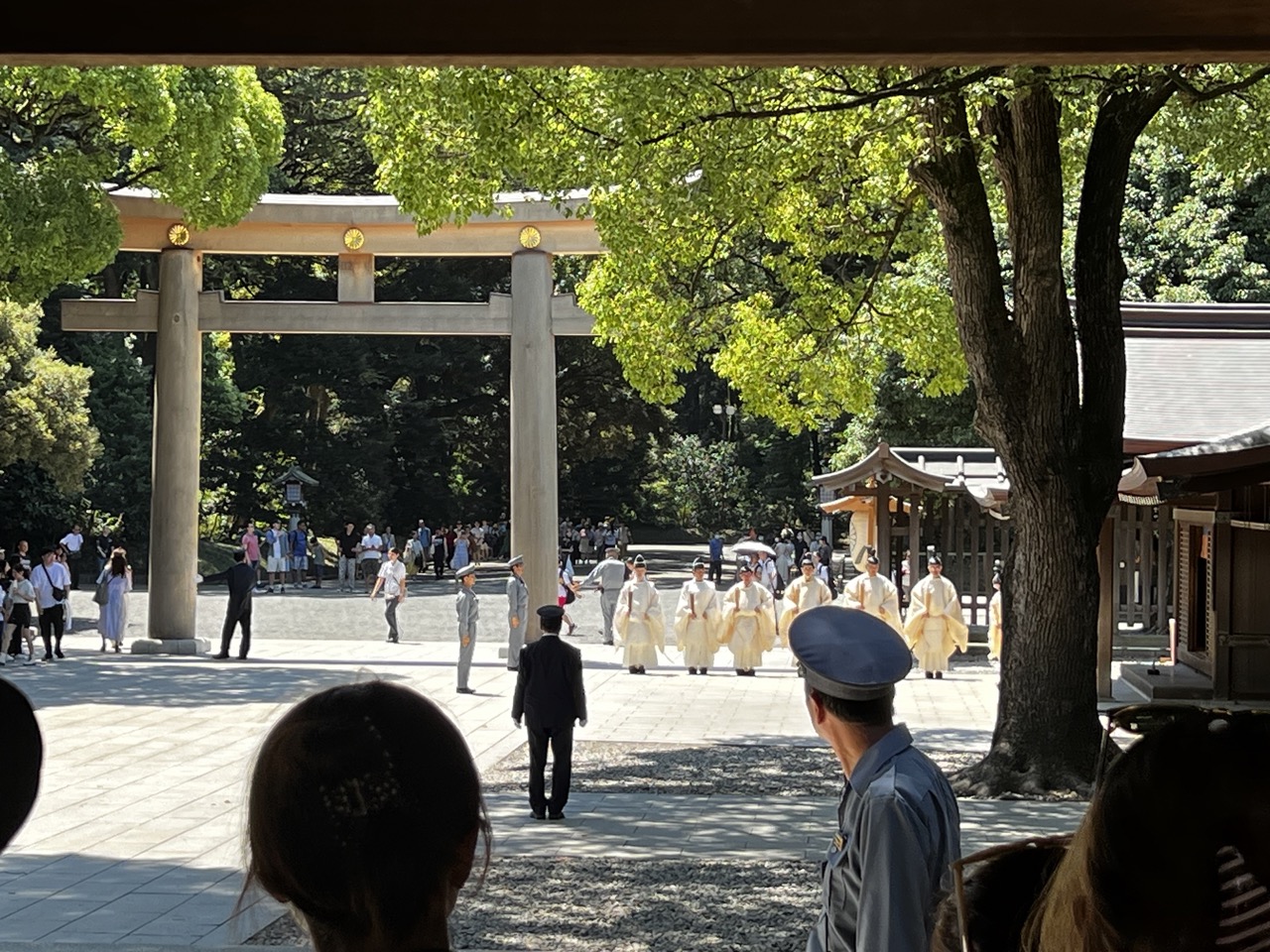

1. Overall Rating (0–10) — 7.5
This photograph captures a serene and culturally rich moment at a Shinto shrine, where tradition and daily life converge under dappled sunlight. The framing from behind onlookers creates a sense of immediacy, drawing the viewer into the procession as if they were present. While the image effectively conveys the atmosphere of reverence and ritual, the composition’s slight imbalance and busy foreground distract from the central ceremony’s elegance.
2. Composition (0–10) — 6.5
The shot is framed from behind spectators, creating a layered perspective that adds depth but also introduces visual clutter. The torii gate serves as a strong focal point, though the placement of the figures and the tree on the right edge slightly disrupts the symmetry and balance of the scene.
3. Lighting (0–10) — 8.0
Natural sunlight filters through the canopy, casting soft, dynamic shadows that enhance texture and depth. The interplay of light and shade across the stone pavement and ceremonial figures adds a painterly quality, while the bright highlights on the white robes emphasize their purity and significance.
4. Color & Tone (0–10) — 7.0
The palette is dominated by the warm golds of the torii and the crisp white of the ceremonial garments, contrasted against the lush greens of the trees and the muted grays of the stone. The tonal range is balanced, with a natural warmth that enhances the spiritual atmosphere without overpowering the scene.
5. Creativity (0–10) — 7.5
The photographer captures a candid yet meaningful moment, blending cultural documentation with artistic framing. The use of the foreground as a narrative device—observers watching the ritual—adds a layer of storytelling, suggesting both continuity and reverence.
6. Technical Quality (0–10) — 8.0
The image is sharp and well-focused, with clear detail in the subjects and textures of the environment. The exposure is balanced, preserving detail in both highlights and shadows, and the camera appears to have captured the moment with minimal noise.
7. Emotional Impact (0–10) — 7.0
The photograph evokes a sense of quiet reverence and cultural continuity, inviting the viewer to reflect on the enduring nature of tradition. The presence of both participants and onlookers creates a shared emotional space, though the distance created by the framing limits the intimacy of the moment.
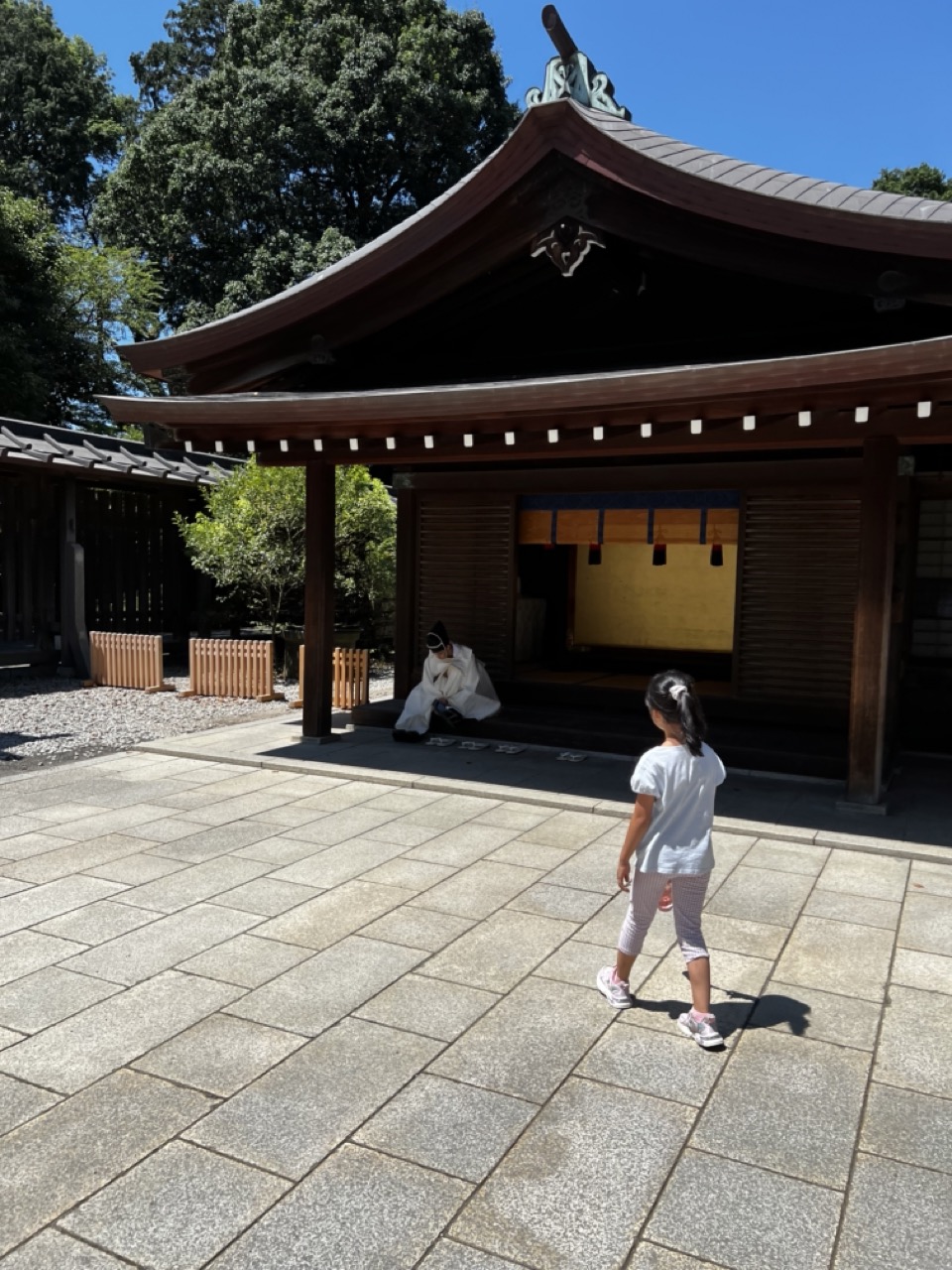

1. Overall Rating (0–10) — 7.0
This photograph captures a quiet, contemplative moment at a Japanese shrine, where tradition and childhood curiosity intersect under a clear blue sky. The contrast between the still, ceremonial figure in white robes and the casual, observant child creates a narrative of cultural transmission, while the clean lines of the architecture and natural light lend the scene a serene dignity. While the composition is strong, the image feels slightly distant, as if capturing a fleeting moment without fully drawing the viewer into its emotional core.
2. Composition (0–10) — 7.0
The wide-angle framing includes both the child in the foreground and the shrine figure in the background, creating a sense of spatial depth. The diagonal lines of the stone pavement lead the eye toward the subject, though the child’s placement on the right edge slightly disrupts balance.
3. Lighting (0–10) — 8.0
Bright, direct sunlight enhances the clarity and crispness of the scene, casting sharp shadows that emphasize form and texture. The overhead light highlights the architectural details and creates a warm, inviting atmosphere.
4. Color & Tone (0–10) — 7.0
The palette is dominated by natural earth tones—gray stone, brown wood, and deep green foliage—accented by the white of the child’s shirt and the ceremonial robe. The vibrant blue sky adds a pop of color that lifts the image without overwhelming the composition.
5. Creativity (0–10) — 7.0
The juxtaposition of a modern child and a traditional religious figure introduces a narrative layer that feels both authentic and thoughtfully composed. The image suggests a quiet continuity between generations, offering a subtle commentary on cultural preservation.
6. Technical Quality (0–10) — 8.0
The image is sharp and well-focused, with clean detail throughout the frame. The exposure is balanced, preserving both highlights and shadows without clipping, and the camera’s perspective is stable and deliberate.
7. Emotional Impact (0–10) — 6.5
The scene evokes a sense of reverence and quiet observation, but the emotional resonance is restrained by the distance between the viewer and the subjects. The child’s posture suggests curiosity, but the lack of facial expression limits deeper connection.
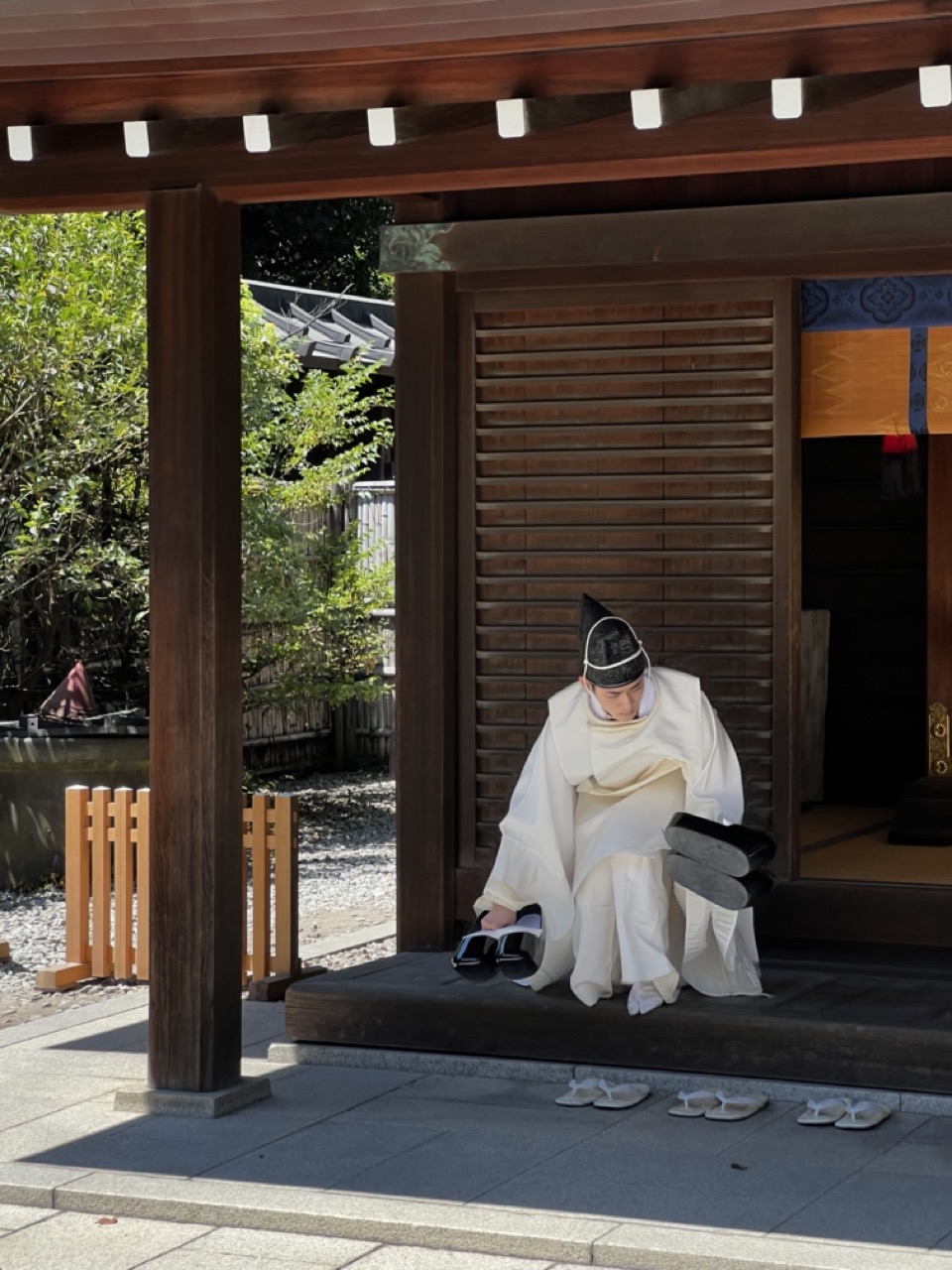

1. Overall Rating (0–10) — 7.5
This photograph captures a moment of quiet reverence within a traditional Japanese shrine, where the stillness of ritual is underscored by the subject’s solemn posture. The harmony between the white robes, dark wood, and natural light lends a meditative quality to the scene, though the composition’s slight imbalance and overexposed background temper its overall impact. The image succeeds in evoking a sense of cultural depth and spiritual focus, even if it stops short of transcendent beauty.
2. Composition (0–10) — 6.5
The subject is well-placed but slightly off-center, with a strong vertical element from the pillar on the left creating visual tension. The foreground shoes and gravel path add narrative context but also clutter the lower frame, slightly disrupting the balance.
3. Lighting (0–10) — 7.0
Natural daylight illuminates the scene clearly, with soft shadows defining form and texture. The overhead eaves create a gentle contrast between light and shadow, enhancing the contemplative mood without harshness.
4. Color & Tone (0–10) — 7.0
The palette is restrained and harmonious—white, black, and warm brown tones dominate, with a touch of green from the trees adding subtle vibrancy. The contrast is moderate, allowing the subject to stand out without overwhelming the scene.
5. Creativity (0–10) — 7.5
The image captures a culturally rich moment with authenticity and respect. The inclusion of everyday details—like the sandals and wooden fence—grounds the ritual in reality, offering a quiet narrative of tradition in practice.
6. Technical Quality (0–10) — 8.0
Sharp focus is maintained on the subject, with clean detail in the fabric and wood textures. The exposure is generally well-managed, though the background foliage is slightly overexposed.
7. Emotional Impact (0–10) — 7.0
The image conveys a deep sense of peace and introspection, inviting the viewer to reflect on the quiet dignity of ritual. The subject’s downward gaze and stillness create a powerful emotional resonance, though the lack of direct engagement keeps the viewer in a respectful distance.


1. Overall Rating (0–10) — 7.0
This photograph captures a whimsical and inviting corner of a Snoopy-themed café, where playful design meets urban greenery. The vibrant red doghouse and cheerful signage create a sense of nostalgia and charm, while the natural foliage softens the hard lines of the surrounding architecture. Though the scene is slightly cluttered with signage and pavement elements, the overall mood is light and welcoming, with a strong sense of place that feels both curated and authentic.
2. Composition (0–10) — 6.5
The frame is well-balanced with the red doghouse and sign drawing the eye, though the cluttered foreground and background slightly distract from the central subject. The diagonal path and tree create leading lines that guide the viewer into the scene.
3. Lighting (0–10) — 7.5
Bright, natural sunlight enhances the vividness of the red doghouse and the lush greenery, casting soft shadows that add depth. The lighting feels candid and warm, contributing to the scene’s cheerful, daytime ambiance.
4. Color & Tone (0–10) — 7.0
The palette is dominated by the bold red of the doghouse and the deep greens of the foliage, creating a strong visual contrast. The neutral tones of the pavement and building help the colorful elements stand out without overwhelming the composition.
5. Creativity (0–10) — 7.5
The choice to highlight a themed café space with a playful, pop-culture motif is clever and engaging. The integration of the Snoopy branding into a real-world urban setting feels both imaginative and grounded in a recognizable cultural touchstone.
6. Technical Quality (0–10) — 7.0
The image is sharp and well-focused, with clear details in the signage and foliage. The exposure is balanced, capturing both highlights and shadows effectively without harsh overexposure.
7. Emotional Impact (0–10) — 7.0
The photograph evokes a sense of joy and nostalgia, particularly for fans of the Peanuts characters. It invites the viewer into a small, cheerful escape within the city—a place where whimsy and everyday life intersect.
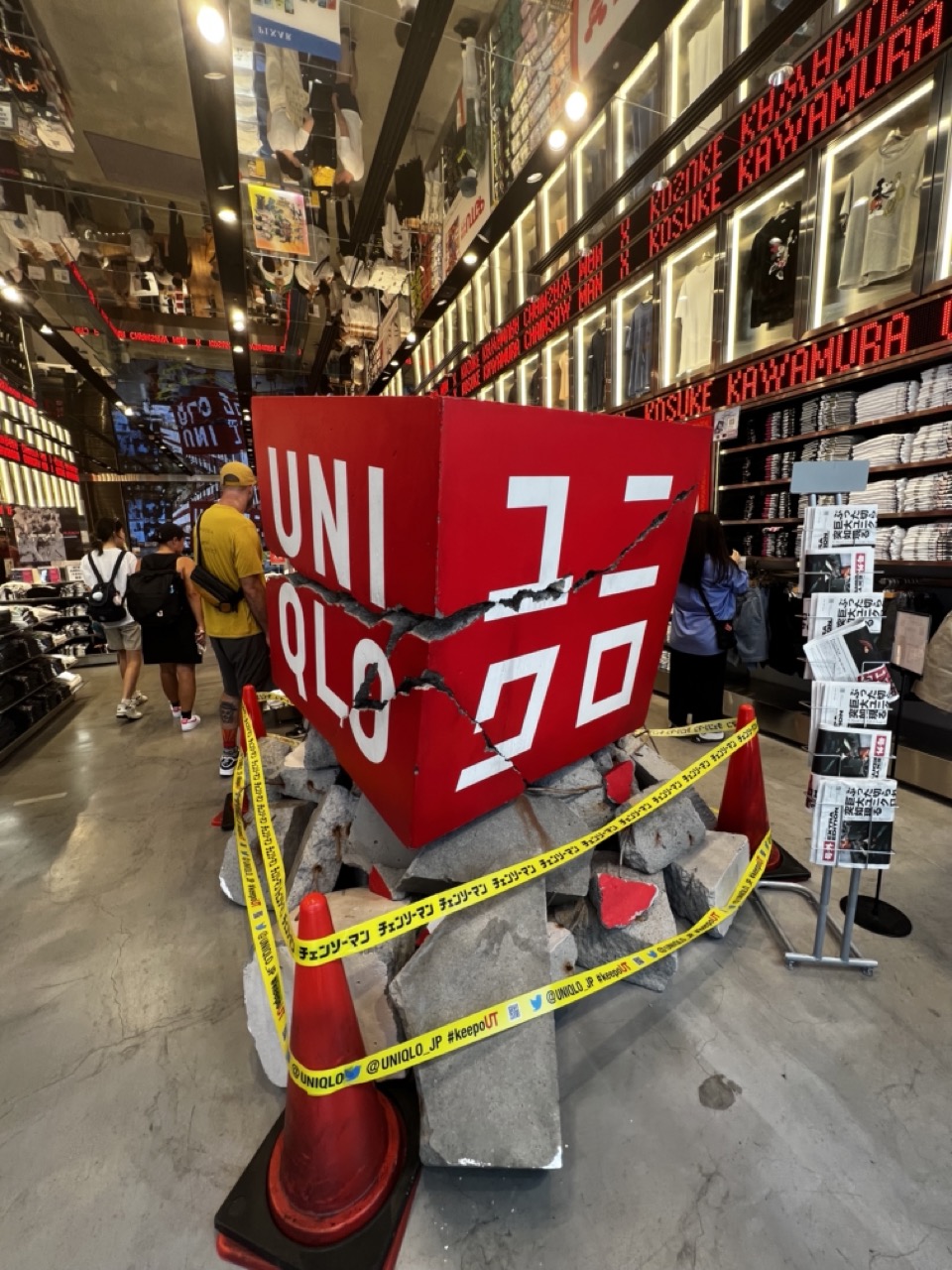

1. Overall Rating (0–10) — 7.0
This photograph captures a bold, conceptual retail installation that merges branding with dramatic visual storytelling. The cracked UNIQLO cube, surrounded by debris and caution tape, creates a striking contrast against the polished, orderly backdrop of the store. While the image effectively communicates a theme of disruption and renewal, its busy environment and cluttered framing slightly diminish the impact of the central sculpture.
2. Composition (0–10) — 6.5
The central cube is well-framed and dominates the visual field, but the surrounding activity and reflections in the glass disrupt the balance. A tighter crop would enhance focus on the installation, while the low-angle perspective adds dynamism.
3. Lighting (0–10) — 7.0
The overhead lighting is bright and functional, typical of a retail space, which highlights the red cube and its fractured surface. The reflections on the glass add complexity but slightly interfere with clarity, particularly in the background.
4. Color & Tone (0–10) — 7.5
The bold red of the UNIQLO cube stands out vividly against the neutral grays and whites of the store interior. The yellow caution tape adds a pop of complementary color, enhancing visual interest and reinforcing the theme of warning or disruption.
5. Creativity (0–10) — 8.0
The concept of a shattered cube is a strong metaphor, likely symbolizing innovation or breaking through boundaries. The integration of branding with a dramatic, almost apocalyptic aesthetic demonstrates originality and a clear artistic intent.
6. Technical Quality (0–10) — 7.5
The image is sharp and well-exposed, with clear details in the cube, tape, and surrounding objects. The reflections and depth of field are managed effectively, though minor distractions from background elements reduce overall clarity.
7. Emotional Impact (0–10) — 6.5
The scene evokes a sense of tension and intrigue, inviting viewers to question the meaning behind the destruction. While the concept is compelling, the commercial context and lack of human engagement limit deeper emotional resonance.
Loading map...